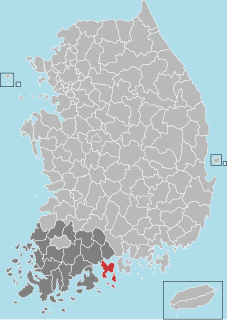
The Changbai Mountains are a major mountain range in Northeast Asia. The mountains extend from the Northeast Chinese provinces of Heilongjiang, Jilin and Liaoning, across the border between China and North Korea, to the North Korean provinces of Ryanggang and Chagang. They are also referred to as the Šanggiyan, Jangbaek, or Ohnan mountains. Most peaks exceed 2,000 metres in height, with the highest being the Paektu Mountain.

Yeosu is a city located on the southern coast of the Korean Peninsula in South Jeolla Province, South Korea and comprises the Old Yeosu City, founded in 1949, Yeocheon City, founded in 1986, and Yeocheon County which were merged into the current Yeosu city in 1998.

Gwangyang is a city in South Jeolla Province, South Korea. Gwangyang city is the home of POSCO's Gwangyang Steel Works, the largest facility of its kind in the world. The city is also home to K League Classic football side Jeonnam Dragons.
Vyalova cave is a cave in a lower plateau of the Chatyrdag mountain, Crimea. It also has an 'old' name: Togerik-Alan-Hosar (Тогерик-Алан-Хосар).
Cheongpyeong is a small town about 1 hour east of Seoul, South Korea, in Gapyeong County, Gyeonggi Province. It has a population of approximately 20,000. It is serviced by 3 schools: an elementary, middle and high school.
Sangam-dong is a legal dong, neighbourhood of the Mapo-gu district in Seoul, South Korea.
Gwaneumsan is a mountain in the city of Pocheon, Gyeonggi-do in South Korea. It has an elevation of 733 m (2,405 ft).
Ungilsan is a mountain near the city of Namyangju, Gyeonggi-do in South Korea. It has an elevation of 610.2 m (2,002 ft).
Jewangsan is a mountain between the county of Pyeongchang and the city of Gangneung, Gangwon-do in South Korea. It has an elevation of 840.6 m (2,758 ft).
Samyeongsan is a mountain between the counties of Yanggu, Hwacheon and the city of Chuncheon, Gangwon-do in South Korea. It has an elevation of 1,197.6 m (3,929 ft).
Gamabong is a mountain of South Korea. It has an elevation of 1,191 metres.
Hyeongjebong is a mountain of South Korea. It has an elevation of 1,778 metres.

Maisan is a mountain of Jeollabuk-do, western South Korea. It has an elevation of 686 metres.
Geumjeonsan is a mountain of Jeollanam-do, southwestern South Korea. It has an elevation of 668 metres.
Illimsan is a mountain of Jeollanam-do, southwestern South Korea. It has an elevation of 668 metres.
Palyeongsan is a mountain of Jeollanam-do, southwestern South Korea. It has an elevation of 609 metres.
Samjeongsan is a mountain of Jeollanam-do, southwestern South Korea. It has an elevation of 1,225 metres.
Juwangsan is a mountain of Gyeongsangbuk-do, eastern South Korea. It has an elevation of 721 metres.
Bulmosan is a mountain of Gyeongsangnam-do, southeastern South Korea. It has an elevation of 399 metres.
The Battle of Chuncheon was one of a series of coordinated attacks beginning on 25 June 1950 that marked the beginning of the Korean War.





